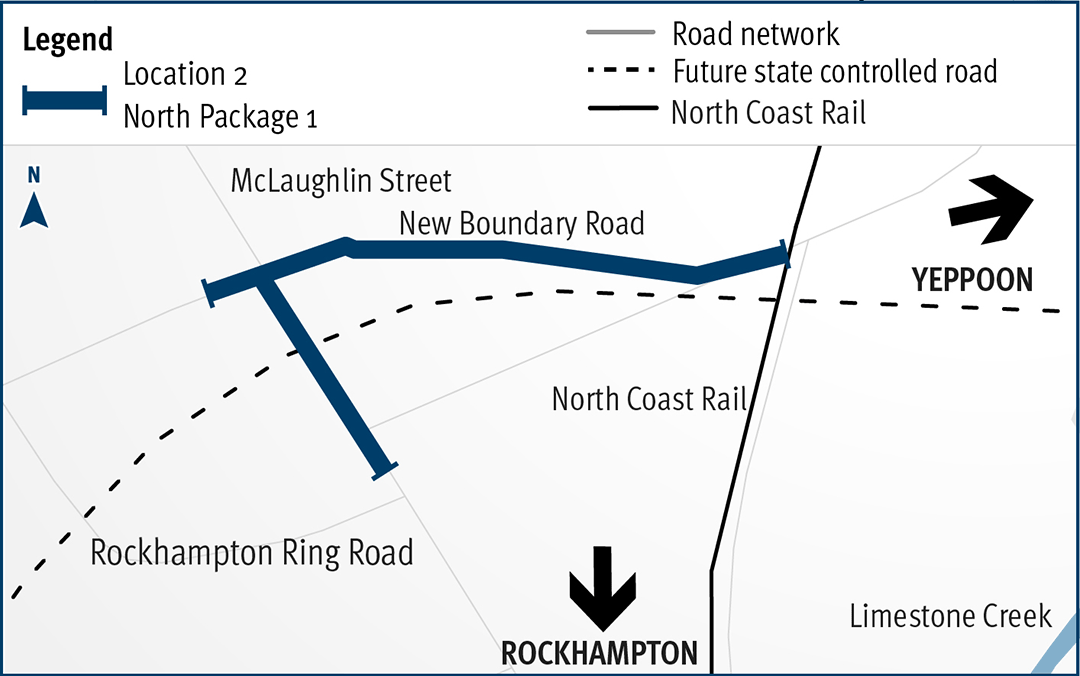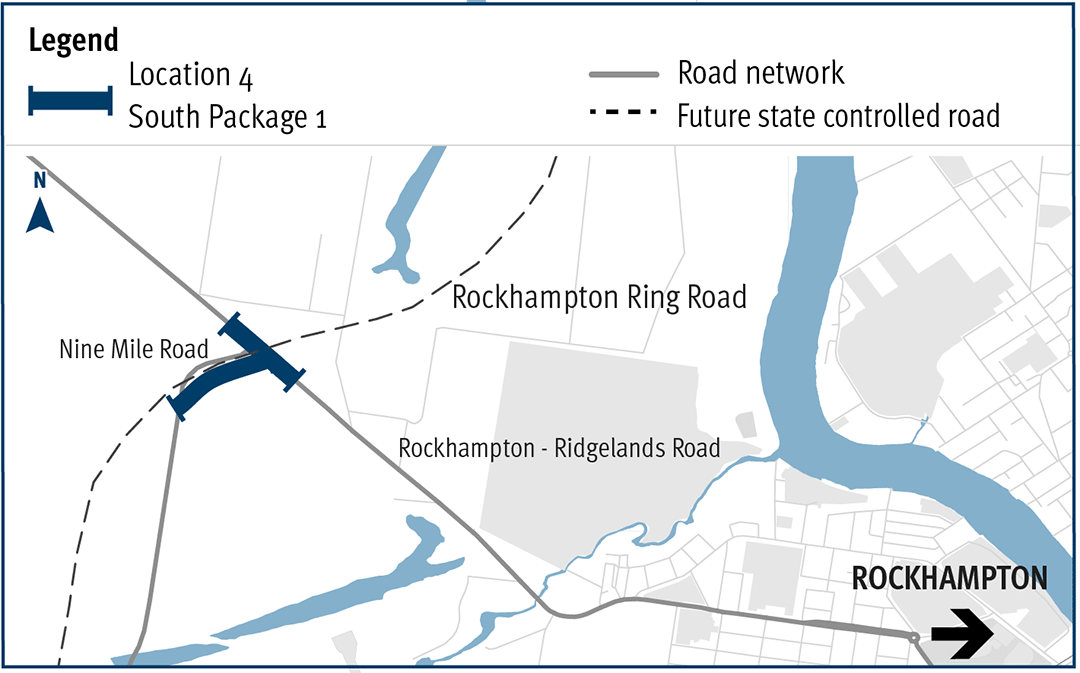Rockhampton Ring Road
The Rockhampton Ring Road is a long-term, visionary project for the Bruce Highway. It will unlock future economic growth and deliver significant benefits including improved flood resilience, freight efficiencies and road safety, and reduced travel times.
In early December 2022, the Australian and Queensland governments agreed to get the first construction phase of Rockhampton Ring Road underway in 2023.
A package of work grouped into North and South location sites has been developed and construction is underway.
North Package 1:
- Construct the ring road section between the Bruce Highway / Rockhampton–Yeppoon Road intersection and Monier Road embankment, including a crossing of Limestone Creek.
- Works required for the realigned Boundary Road, McLaughlin Street, existing Boundary Road, and Monier Road access.
- Construct accesses for Dreamtime Cultural Centre, Queensland Ambulance Service and Queensland Fire and Emergency Services precinct.
South Package 1:
- Rockhampton–Ridgelands Road upgrade including Canoona Road intersection, replacement of Lion Creek bridge, modifications to Osborne Road, and construction of the Ridgelands Road–Osborne Road roundabout with a stub for future connection to the ring road.
- Upgrade of Nine Mile Road / Rockhampton–Ridgelands Road intersection.
- Preload of embankment between the Capricorn Highway and Abutment A of Bridge BR04 (over soft soils).
The Rockhampton Ring Road alignment provides a western link of the Bruce Highway, extending from the Capricorn Highway (at Nelson Street) in the south through to Bruce Highway / Rockhampton-Yeppoon Road intersection in the north. This will include a new crossing of the Fitzroy River.
The project will improve connectivity to priority facilities, services and precincts in Rockhampton by increasing the number of access points to the city.
The Bruce Highway is Queensland's major north-south freight and commuter corridor and stretches over 1,673km connecting coastal population centres from Brisbane to Cairns.
The existing Bruce Highway through Rockhampton is one of the remaining pinch points between Brisbane and Cairns, with 19 sets of traffic signals to navigate.
Traffic volumes on the Bruce Highway in Central Queensland range from 2,600 vehicles per day in rural sections to 35,000 vehicles per day in urban centres. An average of 2,640 heavy vehicles travel through Rockhampton daily.
Benefits
- Improves safety
- Increases capacity
- Improves network efficiency
- Increases traffic flow
- Reduces peak hour congestion
- Better road access
- Reduces travel time
- Contributes to regional growth
- Improves ride quality
- Improves flood immunity
- Contributes to economy
Key features
- 17.4 km of new roadway including approximately 14.7 km of ring road alignment.
- New crossing of the Fitzroy River between Pink Lily and Kawana.
- Connections into West Rockhampton in the vicinity of Ridgelands Road, North Rockhampton at Alexandra Street, and the Bruce Highway intersection with Rockhampton—Yeppoon Road at Parkhurst.
- Continued access to the road network during major flooding.
Funding
The Australian Government and the Queensland Government are funding the project. Investment ID 1167108
Funding figures updated January 2024 to reflect increased Australian Government and Queensland Government contributions.
- Total investment
- $1.73 billion
- Australian Government
- $1.2 billion
- Queensland Government
- $530 million
Current status
Both the state and federal governments are committed to delivering the Rockhampton Ring Road project with early works underway, including service relocations and activities, to ready the road corridor alignment for construction.
At the end of June 2023, contracts were awarded to Bielby-BMD Joint Venture (North Package 1) and Acciona-Fulton Hogan Joint Venture (South Package 1).
Construction on this first phase of the project commenced in November 2023 with completion expected mid-late 2025.
Design
The Rockhampton Ring Road design extends from the Capricorn Highway in the south to Rockhampton-Yeppoon Road in the north and contains both rural and urban sections.
The ring road concept and detailed design were developed with a high level of flood immunity, similar to a 1-in-100-year flood event and equivalent to 9.86m on the Rockhampton flood gauge in the Fitzroy River (a 1% annual exceedance probability).
The design includes features, such as bridges and culverts at key locations along the Rockhampton Ring Road, to manage water flow and minimise the impacts of changes in anticipated flood levels as far as practicable.
Environment
The Rockhampton Ring Road project is committed to the protection and sustainability of our unique Fitzroy River Flood Plain environment, culture and heritage. The project team aims to tread lightly, minimise and mitigate impacts, and replenish or enhance where possible.
On 16 June 2020, the Department of Agriculture, Water and the Environment confirmed the project is a controlled action requiring assessment and approval under the Environment Protection and Biodiversity Conservation Act 1999 (EPBC Act).
On 10 March 2022, under the EPBC Act, a 2-week public notification period commenced for community feedback on the preliminary documentation for the Rockhampton Ring Road project. On conclusion, we notified the Department of Agriculture, Water and the Environment that the public notification was conducted with no submissions received.
On 16 June 2022, the Department of Agriculture, Water and the Environment advised approval of the project proposal with conditions for maximum clearance limits for the project area, Environmental Management Plans, water quality management, rehabilitation requirements and compliance reporting, in accordance with Sections 130(1), 133(1) and 134(1A) of the EPBC Act.
Download the EBPC Approval.
The Environmental Management Plan (EMP) has been developed to identify performance outcomes and management measures to minimise potential impacts to environment associated with the construction and operation of the project.
Download the Environmental Management Plan (January 2022)
EPBC Act compliance reports
Download the EPBC – Annual Compliance Report (November 2022 to November 2023).
Culture and heritage
The department recognises the significance of different cultures and the importance of managing Indigenous, historical, shared and natural heritage.
Engagement with the Darumbal People is a priority to appropriately address cultural considerations.
All reasonable practical measures to avoid harming Aboriginal heritage and the conservation of places and areas entered in the Queensland Heritage Register will be taken.









